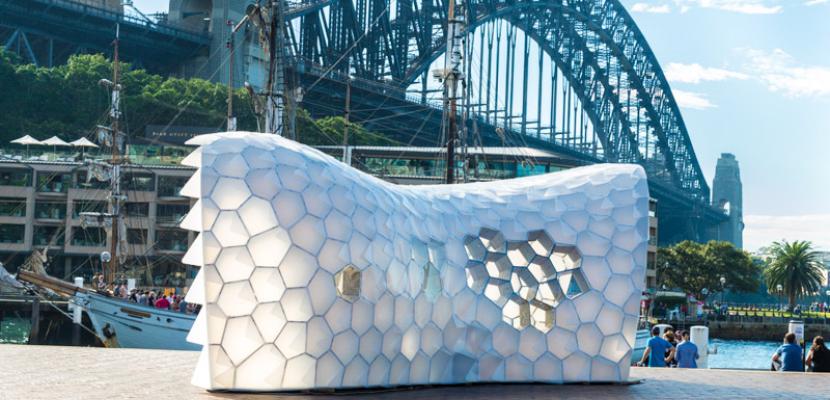
It’s been almost 12 months in the planning but this week, Bond’s Architecture teachers and students are finally seeing their light sculpture, Cellular Tessellation come to life.
The S-shaped pavilion measuring 9 metres long and up to 3.3 metres high was constructed on campus in readiness for its transfer to Sydney where it has been selected for the 2014 Vivid Light Festival. From 23 May to 9 June, it will be viewed by an estimated 800,000 festival-goers as part of the Vivid Light Walk that extends from the Opera House around Circular Quay to The Rocks area.
“We started working on the concept a few months before the Vivid submission date in September last year,” said Assistant Professor Chris Knapp from the Bond University Abedian School of Architecture.
“It’s a complex structure made up of 380 individual cells that each perform a slightly different function so that the surface can curve in different directions.
“Our key challenge was to utilise a novel software application, firstly to test and validate our design theory and then to create digital templates for each individual piece to be laser-cut and CNC-routed in the workshop.
“No two cells in the entire piece are the same shape and size – a bit like the markings on a giraffe – but, with the advanced design and fabrication technology we’ve developed, they will all fit together perfectly.”
Chris worked on the concept and design with fellow Assistant Professor Johnathan Nelson, Masters student Michael Parsons and Fabrications Laboratory Manager Nathan Freeman at the Abedian School of Architecture, in collaboration with Byron-based consulting engineer, Phil Wallace.
Three Bond students who started up their own workshop were brought into the fabrication stage of the project and another team of Architecture students also helped to assemble the finished structure on campus.
“The construction phase is the moment of truth,” said Chris.
“We’ve got 1,200 uniquely shaped pieces and 3,000 bolts and plywood spacers to fit together with absolute precision.
The tunnel-like pavilion is then threaded with 150 metres of strip LED totalling around 4500 lights and sealed with a covering skin of weather-resistant HDPE plastic.
“Aside from the prestige of being accepted for the Vivid Light Festival, the most exciting aspect of this whole project is that the techniques and systems we’ve developed can be universally applied to other structures,” said Chris.
“There are very few people in the world doing this kind of work and only a handful adapting it to a project of this scope and size.
“We’ve pushed the boundaries to find techniques that offer a better way to design and fabricate complex forms and we’ll continue that development by exploring how it can be applied to larger scale buildings.”
Cellular Tessellation will be made available for sale after its showing at Vivid and the Bond team is hoping it will eventually find a home on the Gold Coast.